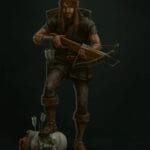So, you dream of thundering into battle atop a majestic griffon, or perhaps outmaneuvering your foes on a nimble lizard? This comprehensive guide will transform you into a master of mounted combat in D&D 5e. Whether you’re a seasoned knight or a curious beginner, prepare to learn the secrets of riding like a champion and crushing your enemies from the saddle (or whatever-back your chosen mount provides).
Choosing the Right Mount: Your Steed of Steel (or Scales, or Feathers…)
Your mount isn’t just a mode of transportation; it’s your battle partner, a crucial component of your mounted combat strategy. Choosing the right mount can mean the difference between a glorious charge and an embarrassing tumble. Consider these factors:
Size Matters
The size of your mount plays a critical role, especially when combined with the Mounted Combatant feat. A larger mount provides advantage on melee attacks against a wider range of creatures. Here’s a breakdown:
| Size Category | Example Creatures | Potential Benefits | Potential Drawbacks |
|---|---|---|---|
| Tiny | Rat, Cat | Extreme maneuverability, stealth | Very fragile, limited carrying capacity |
| Small | Wolf, Goblin | Agile, good for tight spaces | Less imposing, lower carrying capacity |
| Medium | Warhorse, Orc | Balanced speed and strength | Can be cumbersome in tight areas |
| Large | Giant Elk, Hippogriff | Imposing presence, good carrying capacity | Less maneuverable |
| Huge | Mammoth, Giant Scorpion | Extremely tough, terrifying | Very slow, difficult to control |
| Gargantuan | Kraken, Tarrasque | (Probably not advisable) | (Definitely not advisable) |
Terrain and Tactics
A swift warhorse excels on open plains, but a griffon might be preferable in mountainous terrain. Think about where you’ll be fighting and choose a mount that suits the environment. Navigating a dense forest on a huge mammoth is likely to be more of a hindrance than a help.
Creature Statistics
Consider a creature’s stats beyond size. A warhorse capable of charging is ideal for specific combat builds, while a creature with high AC and HP offers greater resilience. Some creatures even possess special abilities, like burrowing or flight, which can drastically change the dynamics of combat.
Carrying Capacity
Need to transport heavy equipment or treasure? A pixie probably isn’t the best choice. A mount with a higher carrying capacity ensures you’re not leaving valuable items behind.
Mounting and Dismounting: Grace Under Pressure
Mounting and dismounting generally require an action. However, with a well-trained mount and under favorable circumstances, it might only require a bonus action. Remember, these moments can leave you vulnerable, so plan your maneuvers carefully. Avoid mounting or dismounting in the thick of combat unless absolutely necessary.
Commanding Your Companion: A Symphony of War
You have two primary methods for controlling your mount:
- Controlled Mount: The mount acts as an extension of you, moving on your turn and following simple commands like “Dash,” “Disengage,” or “Dodge.” This provides maximum control but can be mentally taxing.
- Independent Mount: The mount acts on its own initiative, using its own turns and making its own decisions. This offers an additional combatant but requires careful coordination.
Mounted Combatant Feat: Your Key to Cavalry Mastery
The Mounted Combatant feat is your gateway to true mounted prowess. This feat (found in the Player’s Handbook) offers significant advantages:
- Advantage on Melee Attacks: You gain advantage on melee attack rolls against unmounted creatures smaller than your mount. This significantly increases your chances of landing a hit.
- Protecting Your Steed: When an attack targets your mount, you can use your reaction to make the attack target you instead, shielding your companion from harm. You must be wielding a melee weapon, a shield, or nothing to use this feature.
- Staying in the Saddle: Your mount automatically succeeds on saving throws against being knocked prone. Any effect that would knock you prone while mounted instead knocks you off your mount, but both you and your mount land on your feet, ready to continue the fight.
Tactical Considerations: Riding to Victory
Mounted combat offers unique tactical opportunities:
- Mobility: Swiftly reposition yourself to flank enemies, charge into their lines, or retreat from dangerous situations.
- Height Advantage: Attack from an elevated position, making it harder for smaller creatures to reach you.
- Intimidation: A mounted warrior presents a formidable sight, potentially demoralizing opponents.
However, there are also challenges:
- Larger Target: Your mount, and by extension you, become a bigger target for enemy attacks.
- Limited Maneuverability: Navigating tight spaces, forests, or dungeons can be difficult.
- Vulnerability to Ranged Attacks and Spells: Mounted combatants can be easier targets for ranged attacks, especially area-of-effect spells.
Building Your Mounted Masterpiece: Class Combinations
Some classes, like the Paladin, Fighter, and Ranger, are naturally suited to mounted combat. However, creativity is key. A mounted Sorcerer or Wizard, casting spells from atop a griffon, can be incredibly effective.
Alternatives to the Feat: Spells and Class Features
If you lack a feat slot, consider these alternatives:
- Find Steed: This spell grants a loyal, powerful mount.
- Cavalier Fighter: This subclass provides mounted combat benefits without requiring a feat.
The Best Mounted Weapons: Tools of the Trade
While the lance is often considered the quintessential mounted weapon (offering one-handed use, shield compatibility, and double damage on a charge), other options exist:
- Reach Weapons: Glaives and whips provide range and safety.
- Ranged Weapons: Bows, crossbows, and javelins remain highly effective, especially with cover from your mount.
Sharpen your skills beyond the battlefield: OSRS Fletching Boost
Even seasoned adventurers can benefit from honing their crafting skills. Boost your fletching in Old School RuneScape to craft powerful ammunition and enhance your overall gameplay.
Beyond the Basics: Advanced Tactics and Storytelling
Mounted combat is more than just mechanics; it’s a storytelling opportunity. Develop your character’s backstory, personality, and role within the campaign through their relationship with their mount. Explore unconventional mounts and challenges to create unique and engaging gameplay. Experiment with multiclassing options, such as a Barbarian/Paladin, to discover powerful new combinations. Remember, the possibilities are as vast as the world you explore. Work with your DM to discover unique mounts and adapt your strategies to the specific challenges of your campaign. While this guide provides a comprehensive foundation, rules interpretations can vary. Consult your DM for the final say in your game. Now, saddle up and ride to victory!
- Unveiling Bernhard Caesar Einstein’s Scientific Achievements: A Legacy in Engineering - July 15, 2025
- Uncover who is Jerry McSorley: CEO, Family Man, Business Success Story - July 15, 2025
- Discover Bernhard Caesar Einstein’s Scientific Contributions: Unveiling a Legacy Beyond Einstein - July 15, 2025















